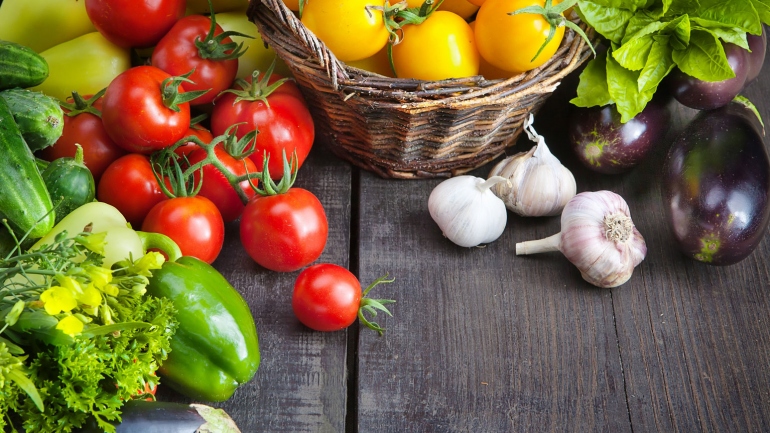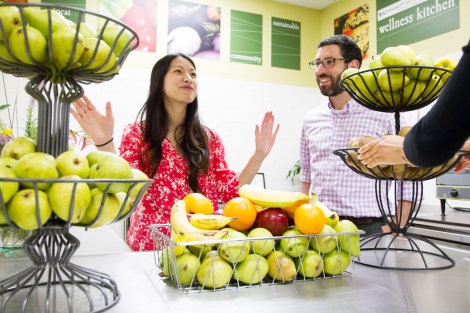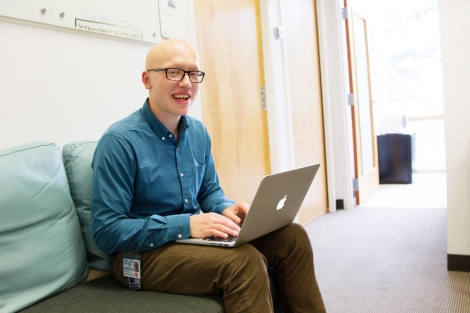Student Projects Get Creative to Encourage Healthy Eating
2 Students Join UC Global Food Initiative’s Mission to Feed the World Nutritiously, Sustainably

Unlike writing a prescription for a pill, helping patients change their eating habits isn’t something easily fixed in the average doctor’s visit.
Two UC San Francisco students are working to change that, as part of the University of California Global Food Initiative.
Jacob Mirsky and Jon Schor have each won a $2,500 UC Global Food Initiative Grant to pursue their inventive projects: one that will inform the design of a new food pantry housed inside a hospital to help patients eat healthily at home, and the other that will help people intuitively make healthy food decisions through a new fitness phone app.
Their work is part of UC’s commitment to helping sustainably and nutritiously feed a world population expected to reach 8 billion by 2025. The Global Food Initiative, launched by UC President Janet Napolitano in January, calls on faculty, staff and students across the system to contribute to solutions that improve food security, health and sustainability.
Mirsky’s and Schor’s projects are designed to move beyond the ubiquitous, yet largely ineffective, health message of instructing people “to eat better” and to actually meet people where they are.
A Prescription for Vegetables
Mirsky, a student in the School of Medicine, is working on a new project being developed by UCSF faculty that will allow physicians to actually write a prescription for healthy food – and for patients to pick it up that same day at a food pantry housed on location at San Francisco General Hospital and Trauma Center (SFGH). Scheduled to open this May, the food pantry is part of the hospital’s wellness program, funded and operated by SFGH.

Rita Nguyen, MD, and student Jacob Mirsky show off the future food pantry in the Community Wellness Center of San Francisco General Hospital and Trauma Center. Mirsky received a grant to support the project from the UC Global Food Initiative. Photo by Susan Merrell
To help make this hospital-based food pantry as effective as possible, Mirsky is interviewing a range of patients who are “food insecure,” a term that refers to going hungry or being at risk for going hungry.
“I think it’s important that I learn more about the challenges of food insecurity and how it affects people to inform how I’ll interact with patients as a doctor,” said Mirsky. “Helping patients eat better isn’t just about providing fruits and vegetables but also considering what other factors affect the way we eat.”
Mirksy said a few patients in his focus group talked about how sadness and depression made it harder for them to stick to healthy habits every day. One man said he kept a careful budget to buy healthy foods, but sometimes he would get lonely and buy and eat a tub of ice cream.
These are some of the many reasons the SFGH food pantry is striving to go beyond simply putting fruits and vegetables in patients’ hands.
“It’s more than just a food dispensary,” said Rita Nguyen, MD, a UCSF assistant professor of medicine who has long been involved in social justice work and who is spearheading the food pantry development. “It’ll be staffed by a nutritionist who can help with what foods to eat or avoid for diabetes, and various other conditions.
“The patient is already coming to the doctor, then going upstairs to get medications – and now food. So it sends the message about the therapeutic link, that food is important to your health.”
There will also be classes teaching healthy cooking techniques and strategies for shopping on a budget. Staff will also be trained in helping patients understand and use food stamp programs and other local resources.
“We’ve spent one-and-a-half years building this food pantry, so we’re really trying to make it sustainable and have maximum impact for patients.”
The patient feedback that Mirsky gathers will help inform the design of the pantry, said Nguyen: “He’s very cognizant of not wanting to build something that isn’t useful.”
Nguyen will be tracking health changes in two groups – pregnant women with diabetes and obese children – using a quarterly survey and data from their medical records, to test the impact of the food pantry.
New Meaning to Dancing for Your Dinner
Schor, an MD-PhD candidate in the School of Medicine and Graduate Division, is hoping to boost healthy eating with a different intervention: changing how we interpret nutrition labels.

Student Jon Schor is building an app that would better intepret information in nutrition labels by telling users exactly how much exercise they'd have to do to burn off the foods they choose. Photo by Susan Merrell
We’ve all glanced at a food label before, registered the few hundred calories serving size and still proceeded to munch away. But what if you knew exactly how long you’d have to run to burn off the calories in that bag of chips?
Research suggests that displaying the exercise needed to burn off the calories can be a very effective deterrent to eating and drinking unhealthy foods and beverages, so Schor is developing an app that would show the physical activity equivalent of any food item.
“The goal is to take something that’s not really tractable – a straight caloric number on a nutrition label – and turn it into something that people can readily grasp. In this case, it’s physical activity equivalents,” said Schor.
The app allows the user to choose the activity that is most meaningful for him or her, be it running or walking or tango dancing.
“Rather than simply seeing that a bag of chips is 250 calorie, the app will show you’d have to run 20 minutes at a 8-minute per mile pace to run this off – that tends to be more discouraging then some amorphous caloric number,” he said.
So far, Schor has a working prototype of the app that he has programmed himself. He’s sought advice from researchers at the UCSF Obesity and Weight Management Clinic and read literature about food labels. Going forward, Schor would like to integrate the app into existing healthy eating programs, such as an existing fitness app or working with a small health start-up.
He’s hoping to launch a version of the app next fall.